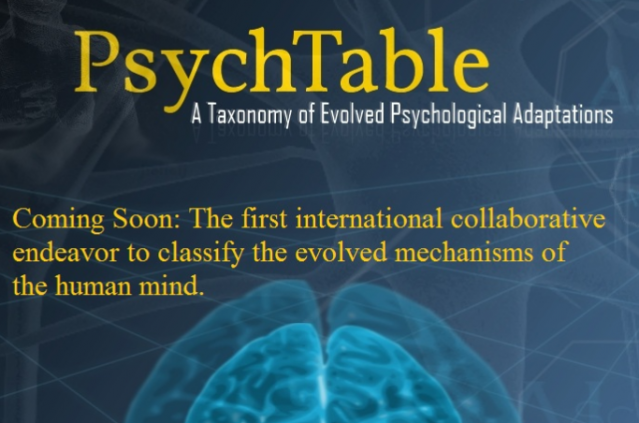Bias
A 'Periodic Table' of Human Psychological Adaptations
PsychTable.org: A classification system for human psychological adaptations.
Updated June 17, 2024
Post by Niruban Balachandran and Michael Mills
Gray's Anatomy (the book, not the TV show) was the first comprehensive attempt to map evolved human physiological adaptations — the organs of the human body. Imagine a similar effort to map human psychological adaptations — sort of a Gray's Anatomy of the mind/brain.
Actually, there is just such a project in progress: PsychTable.org. Its objective is to do for psychology what Gray’s Anatomy achieved for physiology, what Mendeleev’s Periodic Table of Elements did for chemistry, and what the Diagnostic and Statistical Manual of Mental Disorders did for psychiatry and clinical psychology.
A New Foundation for Mapping Human Nature
In 1859 Charles Darwin envisioned "a new foundation for psychology" — the identification of each evolved “mental power and capacity” of the mind/brain. He predicted: "Much light will be thrown on the origin of man and his history” via an understanding of how and why such mental faculties evolved (Darwin, 1859, p. 488).
However, it took more than a century before someone took on Darwin's challenge to develop a list of proposed evolved psychological adaptations (or, "EPAs"). In 1991 anthropologist Donald Brown published his classic book Human Universals. In it he compiled a list of what he called “surface universals” (overt behaviors such as: facial expressions, language, fear of strangers, sexual jealousy, etc.) that had been noted by ethnographers in peoples across all cultures, even those widely separated in space and/or time. His list of human universals was one of the first attempts to map human nature.
In 1992 Leda Cosmides and John Tooby published their classic evolutionary psychology manifesto in a chapter of the The Adapted Mind. They called for the further development of a taxonomy of evolved psychological adaptations:
Just as one can now flip open Gray's Anatomy to any page and find an intricately detailed depiction of some part of our evolved species-typical morphology, we anticipate that in 50 or 100 years one will be able to pick up an equivalent reference work for psychology and find in it detailed information-processing descriptions of the multitude of evolved species-typical adaptations of the human mind, including how they are mapped onto the corresponding neuroanatomy and how they are constructed by developmental programs.
The list of human EPAs proposed by researchers has been growing at a substantial pace over the last several decades. These include humans’ wariness around snakes, physical pain, spatial orientation devices, color vision, core disgust, sense of number, recognition of facial expressions, anti-predator directed gaze reflex, incest avoidance bias, sexual jealousy, preference for low morphological fluctuating asymmetry, genetic relatedness-induced bias for altruism toward kin, language acquisition devices, optimal foraging bias, preference for sugary foods, etc.
In 2002, Plutchik developed a list of emotional adaptations, and classified them by their associated initiating stimulus event, their associated cognitive, feeling, and behavioral states, and their evolutionary function (adaptive effect).

Given the growing number of proposed and empirically supported EPAs in the scientific literature, and inspired by Plutchik's classification system, in 2003 one of us (Mills) developed a taxonomy for EPAs. EPAs were first grouped to several levels of adaptive problems: survival, reproduction, kin altruism, reciprocity with non-kin, and memetics.

Levels of Adaptive Problems
Next, some of the specific manifestations and operations of these EPAs would be detailed. The goal was to produce something akin to a Periodic Table of Evolved Psychological Adaptations.

How psychological adaptations might be categorized.
I presented a poster that outlined some of these ideas, titled Toward a Classification Table of Human Psychological Adaptations (available here) at the 2003 Human Behavior and Evolution Society conference. Each proposed EPA was classified by level, as well as the specific adaptive problem, and associated motive/emotion, function, stimulus, behavior, cognition and proposed adaptive effect.
In attendance at the conference was Niruban Balachandran, then a psychology student from Rutgers. He was intrigued by the idea of a classification system for EPAs, and he emailed me about it after the conference. Recently Niruban extended some of my ideas and began developing a web-based collaborative project to help to identify EPAs. He envisioned an international, collaborative science project to create a taxonomy of EPAs. The web-based collaborative system would allow scientists to work together to both classify and evaluate the evidence for each proposed EPA. Niruban presented his ideas at the 2008 International Society for Human Ethology Conference in Bologna, Italy. He later published an article about it in The Journal of Social, Evolutionary and Cultural Psychology.
PsychTable.org: An Academic Collaborative to Develop a Taxonomy of EPAs
This year Niruban teamed up with several collaborators and advisers to create a web-based academic collaborative: PsychTable.org.

Scientists, educators, students, and the general public will soon be able to use PsychTable.org to:
• Explore detailed descriptions of hundreds of proposed evolved psychological adaptations
• Connect directly with a worldwide community of scientists, educators, students, contributors, and the general public
• Evaluate the existing literature to determine how robustly any purported EPA is empirically supported
• Help compile individual dossiers that profile individual EPAs' neurolocalizations, neurochemical substrates, elicitors, outputs, and so on
• Nominate hypothesized EPAs that may be substantiated via emerging research
• Gain insight into which areas of evolutionary social scientific research that are open to further empirical inquiry
• Provide a helpful Web-based study tool for students
PsychTable.org uses Schmitt and Pilcher's (2004) system for evaluating both the quantity and quality of evidence for EPAs. Evidence to corrobrate a trait as an EPA can come from diverse sources: theoretical, psychological, medical, physiological, genetic, phylogenetic, hunter-gatherer, and cross-cultural evidence (Balachandran & Glass, 2012). By weighing the evidence for each EPA, PsychTable.org will provide an integrative resource to display which proposed EPAs currently have strong empirical support. Below is a sketch of how an individual EPA listing in Psych Table may appear:

Example of An EPA Description in Psych Table.
However, like other online collaborative efforts, such as Wikipedia and the Encyclopedia of Life, PsychTable will likely encounter some challenges. Collaboration among scientists can be difficult at times, partly because they get rewards from their universities for publishing their own articles rather than for contributing a relatively small part to a large collaborative project. Also, identifying EPAs can be challenging. All human traits are not adaptations, they may be a byproduct of an adaptation, or, random variation (see this post). Which psychological traits are sexually monomorphic and which are sexually dimorphic? There are also challenges associated with specifying the specific boundaries and attributes of an adaptation. Also, it is likely that many EPAs fall into multiple hierarchical systems with complex and overlapping boundaries.
A beta version of PsychTable.org is expected to be available in early 2013. To learn more about the PsychTable.org project, see Balachandran’s and Glass’ recently-published article in the journal Evolution: Education and Outreach, here. Also, check out the PsychTable.orgwebsite, especially the FAQ page. The project team is currently upgrading the site for use by the international research community and the general public. Stay tuned.
Before too long, we may have a Gray's Anatomy of the human mind.
Note: This post is partially adapted from: Balachandran, N., & Glass, D. J. (2012). PsychTable.org: The taxonomy of evolved human psychological adaptations. Evolution: Education and Outreach, 5, 312-320.




